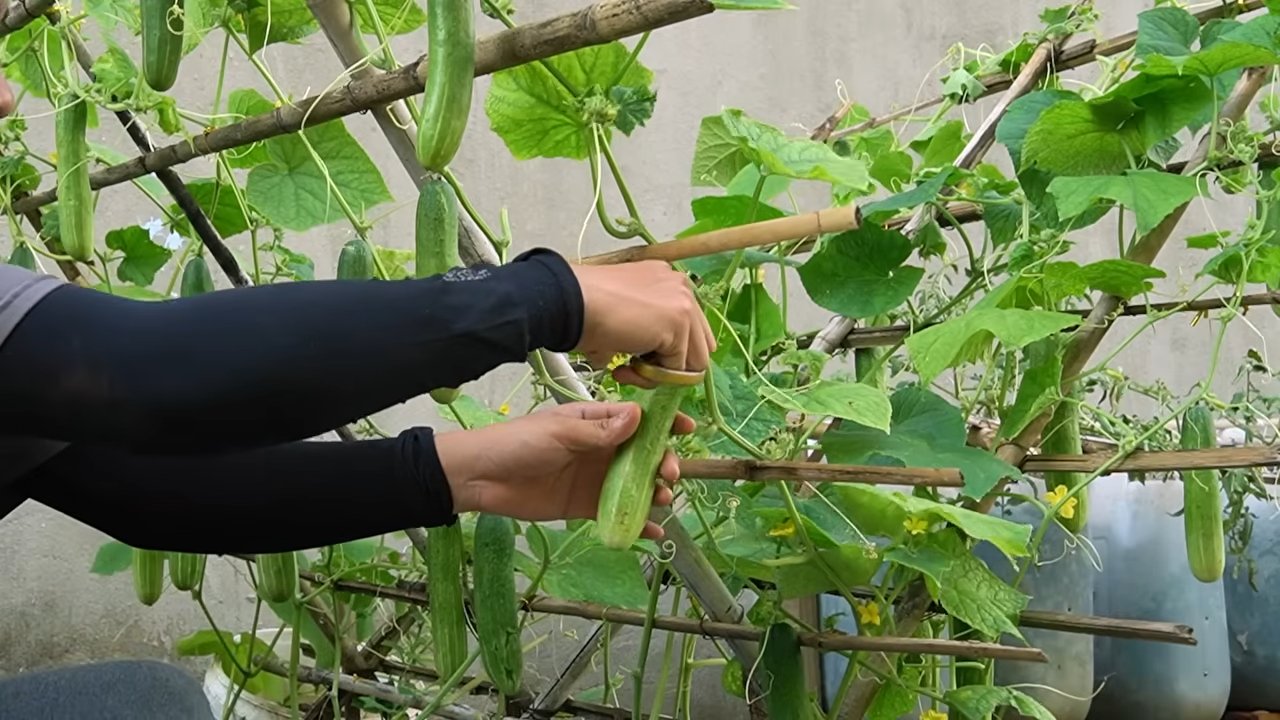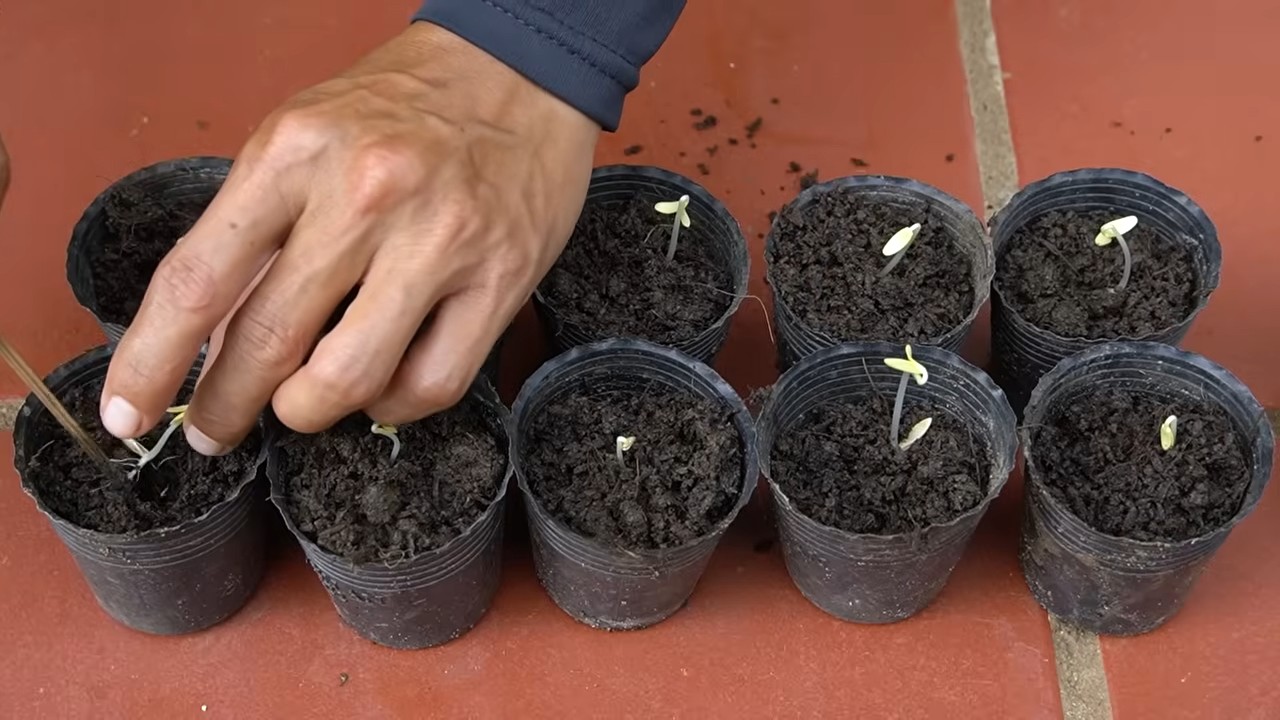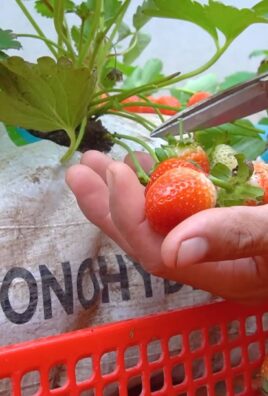Small space cucumber gardening doesn’t have to be a pipe dream, even if you’re working with a tiny balcony or just a sunny windowsill! Are you dreaming of vine-ripened cucumbers bursting with flavor, but think you lack the sprawling garden needed to grow them? I’m here to tell you that you absolutely *can* cultivate these crisp, refreshing veggies, no matter how limited your outdoor area may be.
Cucumbers have a rich history, dating back thousands of years to their origins in India. They’ve been enjoyed by cultures across the globe, from ancient Romans to modern-day foodies. But traditionally, growing cucumbers meant dedicating a significant patch of land to their sprawling vines. Thankfully, times have changed!
In today’s world, many of us are living in apartments, condos, or homes with smaller yards. We crave fresh, healthy produce, but the idea of a traditional garden feels overwhelming. That’s where these DIY tricks and hacks for small space cucumber gardening come in. I’ll show you how to maximize your yield, choose the right varieties, and create a thriving cucumber patch, all without sacrificing precious square footage. Get ready to enjoy delicious, homegrown cucumbers all season long!

DIY: Growing Cucumbers in Small Spaces – A Vertical Gardening Adventure!
Hey there, fellow gardening enthusiasts! Dreaming of fresh, crisp cucumbers but short on space? Don’t worry, I’ve got you covered! I’m going to walk you through how to grow cucumbers vertically, maximizing your yield even if you only have a tiny balcony or patio. It’s easier than you think, and the satisfaction of harvesting your own cucumbers is unbeatable.
What You’ll Need: The Cucumber Gardener’s Toolkit
Before we dive in, let’s gather our supplies. Here’s what you’ll need to transform your small space into a cucumber paradise:
* Cucumber Seeds or Seedlings: Choose a bush or compact variety specifically bred for containers. Some great options include Spacemaster, Bush Champion, or Patio Snacker. These varieties are designed to stay relatively small and produce well in limited spaces.
* Large Container: A pot at least 12 inches in diameter and 12 inches deep is crucial. Cucumbers have extensive root systems, so give them plenty of room to grow. Fabric pots are also a great option as they allow for better drainage and aeration.
* High-Quality Potting Mix: Don’t skimp on the soil! Use a well-draining potting mix rich in organic matter. Avoid using garden soil, as it can compact in containers and hinder drainage.
* Trellis or Support Structure: This is key for vertical growing! You can use a tomato cage, a trellis panel, a DIY structure made from bamboo stakes and twine, or even a sturdy fence. The trellis should be tall enough to support the mature cucumber vines, ideally 4-6 feet high.
* Fertilizer: A balanced, slow-release fertilizer or a liquid fertilizer specifically formulated for vegetables will keep your cucumbers happy and productive.
* Watering Can or Hose: Consistent watering is essential, especially during hot weather.
* Gardening Gloves: To keep your hands clean and protected.
* Pruning Shears or Scissors: For trimming and harvesting.
* Optional: Mulch: To help retain moisture and suppress weeds.
Getting Started: Planting Your Cucumber Seeds or Seedlings
Now that we have our supplies, let’s get planting!
1. Prepare Your Container: Fill your container with the high-quality potting mix, leaving a few inches of space at the top.
2. Plant Your Seeds or Seedlings:
* From Seed: Sow 2-3 seeds about 1 inch deep in the center of the container. Gently cover with soil and water thoroughly. Once the seedlings emerge, thin them to the strongest one.
* From Seedling: Gently remove the seedling from its nursery pot, being careful not to damage the roots. Dig a hole in the center of the container large enough to accommodate the root ball. Place the seedling in the hole and backfill with soil, gently firming around the base.
3. Water Thoroughly: Water the newly planted seeds or seedlings deeply until water drains from the bottom of the container. This helps settle the soil and encourages root growth.
4. Add Your Trellis: Position your trellis or support structure in the container, making sure it’s stable and secure. You want it to be able to handle the weight of the mature cucumber vines.
5. Mulch (Optional): Add a layer of mulch around the base of the plant to help retain moisture and suppress weeds.
Nurturing Your Cucumber Vines: Care and Maintenance
Once your cucumbers are planted, it’s time to provide them with the care they need to thrive.
1. Watering: Cucumbers need consistent moisture, especially during hot weather. Water deeply whenever the top inch of soil feels dry to the touch. Avoid overhead watering, as this can lead to fungal diseases. Aim to water at the base of the plant.
2. Fertilizing: Feed your cucumber plants regularly with a balanced fertilizer. Follow the instructions on the fertilizer package. You can use a slow-release fertilizer at planting time or a liquid fertilizer every 2-3 weeks.
3. Training the Vines: As your cucumber vines grow, gently guide them to climb the trellis. You can use soft plant ties or twine to secure the vines to the support structure. Encourage the vines to spread out evenly across the trellis for optimal sunlight exposure.
4. Pruning: Pruning can help improve air circulation and encourage fruit production. Remove any yellowing or diseased leaves. You can also prune some of the side shoots (suckers) that grow from the main stem to encourage more energy to be directed towards fruit development.
5. Pest and Disease Control: Keep an eye out for common cucumber pests like aphids, cucumber beetles, and squash bugs. You can control these pests with insecticidal soap or neem oil. Prevent fungal diseases by providing good air circulation and avoiding overhead watering. If you notice any signs of disease, treat promptly with a fungicide.
6. Sunlight: Cucumbers need at least 6-8 hours of sunlight per day to produce well. Choose a location that receives plenty of sunlight. If you live in a very hot climate, provide some afternoon shade to prevent the plants from overheating.
Harvest Time: Enjoying Your Homegrown Cucumbers
The moment you’ve been waiting for! Harvesting your own cucumbers is incredibly rewarding.
1. Harvesting: Cucumbers are typically ready to harvest about 50-70 days after planting, depending on the variety. Harvest them when they are the desired size and color. Check the seed packet or plant tag for specific harvesting guidelines.
2. How to Harvest: Use pruning shears or scissors to cut the cucumber from the vine, leaving a small stem attached. Avoid pulling the cucumber, as this can damage the plant.
3. Enjoy Your Harvest: Freshly harvested cucumbers taste amazing! Enjoy them in salads, sandwiches, pickles, or simply sliced with a sprinkle of salt.
Troubleshooting: Common Cucumber Growing Challenges
Even with the best care, you might encounter some challenges along the way. Here are some common issues and how to address them:
* Yellowing Leaves: This can be caused by overwatering, underwatering, nutrient deficiencies, or disease. Check the soil moisture and adjust your watering accordingly. Fertilize regularly and treat any signs of disease promptly.
* Lack of Fruit: This can be caused by insufficient pollination, lack of sunlight, or nutrient deficiencies. Ensure your plants are getting enough sunlight and fertilize regularly. You can also hand-pollinate the flowers by transferring pollen from the male flowers to the female flowers with a small brush.
* Bitter Cucumbers: This can be caused by inconsistent watering, high temperatures, or stress. Provide consistent moisture and protect your plants from extreme heat.
* Pest Infestations: Regularly inspect your plants for pests and treat them promptly with insecticidal soap or neem oil.
Choosing the Right Cucumber Variety for Your Space
Selecting the right cucumber variety is crucial for success in small spaces. Here’s a breakdown of some popular options:
* Bush Champion: As the name suggests, this variety is compact and bushy, making it ideal for containers. It produces a good yield of medium-sized cucumbers.
* Spacemaster: Another excellent choice for small spaces, Spacemaster is a compact vine that produces dark green cucumbers. It’s also known for its disease resistance.
* Patio Snacker: This variety is specifically bred for container gardening and produces small, snack-sized cucumbers. It’s perfect for snacking right off the vine.
* Picklebush: If you’re a fan of pickles, Picklebush is a great option. It’s a compact bush variety that produces small, pickling cucumbers.
* Little Leaf: This unique variety has smaller leaves than other cucumber varieties, making it more compact and suitable for small spaces. It produces a good yield of standard-sized cucumbers.
When choosing a variety, consider your personal preferences and the size of your container. Read the seed packet or plant tag carefully to ensure the variety is suitable for your growing conditions.
Building Your Own Cucumber Trellis: A DIY Project
If you’re feeling crafty, you can easily build your own cucumber trellis. Here’s a simple DIY project:
Materials:
* Bamboo stakes (4-6, depending on the size of your container)
* Twine or garden ties
* Measuring tape
* Scissors
Instructions:
1. Measure and Cut: Determine the desired height of your trellis and cut the bamboo stakes to the appropriate length.
2. Arrange the Stakes: Insert the bamboo stakes into the soil around the perimeter of your container, spacing them evenly apart.
3. Create a Framework: Use twine or garden ties to connect the stakes, creating a framework for the cucumber vines to climb. Start by tying the stakes together at the top, then add horizontal supports every 6-12 inches.
4. Add Vertical Supports: Add vertical supports by running twine or garden ties between the

Conclusion
So, there you have it! Transforming your limited area into a thriving cucumber patch is not only achievable but also incredibly rewarding. This DIY trick for small space cucumber gardening is a game-changer for urban gardeners, balcony enthusiasts, and anyone looking to maximize their yield without sacrificing precious square footage. We’ve shown you how to leverage vertical space, optimize sunlight, and create a supportive environment for your cucumber vines to flourish, even when space is at a premium.
But why is this a must-try? Beyond the obvious benefit of fresh, homegrown cucumbers, this method offers several advantages. Firstly, it significantly reduces the risk of soilborne diseases that can plague traditional cucumber patches. By keeping the foliage off the ground, you improve air circulation and minimize the chances of fungal infections. Secondly, vertical gardening makes harvesting a breeze. No more bending and searching through sprawling vines – your cucumbers will be hanging conveniently within reach. Thirdly, and perhaps most importantly, it’s incredibly satisfying to witness the transformation of a small space into a productive garden.
Don’t be afraid to experiment with variations! Consider using different types of containers, such as fabric pots or repurposed buckets, depending on your aesthetic preferences and available resources. You can also explore different trellising options, from simple bamboo stakes to elaborate DIY structures made from recycled materials. For those with limited sunlight, supplemental grow lights can be a lifesaver, ensuring your cucumbers receive the energy they need to thrive. And if you’re feeling adventurous, try growing different varieties of cucumbers, from classic slicing cucumbers to pickling cucumbers or even exotic lemon cucumbers.
This DIY approach to small space cucumber gardening is more than just a gardening technique; it’s an invitation to connect with nature, cultivate your own food, and experience the joy of growing. It’s about proving that even the smallest spaces can yield abundance with a little creativity and effort.
We wholeheartedly encourage you to give this DIY trick a try. The initial setup might require a bit of effort, but the rewards – fresh, delicious cucumbers and the satisfaction of a thriving garden – are well worth it. And remember, gardening is a journey of learning and experimentation. Don’t be discouraged if you encounter challenges along the way. Embrace the process, learn from your mistakes, and celebrate your successes.
Most importantly, we want to hear about your experience! Share your photos, tips, and stories with us. Let us know what worked for you, what challenges you faced, and what delicious cucumber creations you’ve been whipping up. Your feedback will not only inspire other gardeners but also help us refine and improve this DIY trick for small space cucumber gardening. So, grab your seeds, get your hands dirty, and let’s grow some cucumbers together!
Frequently Asked Questions (FAQ)
What type of cucumbers are best for small space gardening?
Compact or bush varieties of cucumbers are generally the best choice for small spaces. These varieties are bred to produce shorter vines, making them ideal for container gardening and vertical growing. Some popular options include Spacemaster, Bush Champion, Salad Bush, and Patio Snacker. These varieties still produce full-sized cucumbers but on a more manageable plant. Vining varieties can also be grown in small spaces, but they require more extensive trellising and pruning to keep them under control. Be sure to check the seed packet or plant label for information on the plant’s mature size and growth habit before making your selection.
How much sunlight do cucumbers need?
Cucumbers are sun-loving plants and require at least 6-8 hours of direct sunlight per day to thrive. Insufficient sunlight can lead to stunted growth, reduced yields, and increased susceptibility to diseases. If you don’t have a spot that receives full sun, consider using supplemental grow lights to provide the necessary light. Position the grow lights close to the plants and adjust their height as the plants grow. Rotate the plants regularly to ensure even light exposure on all sides.
What type of soil is best for growing cucumbers in containers?
Cucumbers prefer well-draining, nutrient-rich soil with a slightly acidic to neutral pH (6.0-7.0). A good potting mix for cucumbers should consist of a blend of compost, peat moss or coco coir, and perlite or vermiculite. Compost provides essential nutrients, while peat moss or coco coir helps retain moisture. Perlite or vermiculite improves drainage and aeration. Avoid using garden soil in containers, as it can become compacted and poorly drained. You can also amend your potting mix with slow-release fertilizer to provide a steady supply of nutrients throughout the growing season.
How often should I water my cucumber plants?
Cucumbers are thirsty plants and require consistent watering, especially during hot weather. Water deeply and regularly, aiming to keep the soil consistently moist but not waterlogged. Check the soil moisture level daily by sticking your finger into the soil. If the top inch feels dry, it’s time to water. Avoid overhead watering, as it can promote fungal diseases. Instead, water at the base of the plants or use a soaker hose or drip irrigation system. Mulching around the plants can also help retain moisture and suppress weeds.
How do I trellis my cucumber plants in a small space?
There are several trellising options for small space cucumber gardening. A simple and inexpensive option is to use bamboo stakes or wooden dowels to create a teepee or A-frame structure. You can also use a wire mesh trellis, a tomato cage, or a repurposed ladder. Attach the trellis securely to the container or a nearby structure. As the cucumber vines grow, gently guide them onto the trellis and tie them loosely with twine or plant clips. Prune any side shoots or suckers that develop to encourage the main vine to grow vertically.
How do I fertilize my cucumber plants?
Cucumbers are heavy feeders and require regular fertilization to produce abundant yields. Start fertilizing your cucumber plants a few weeks after transplanting them into their containers. Use a balanced fertilizer with a ratio of 10-10-10 or 14-14-14. Follow the instructions on the fertilizer label for application rates. You can also use organic fertilizers, such as compost tea, fish emulsion, or seaweed extract. Apply fertilizer every 2-3 weeks throughout the growing season. Avoid over-fertilizing, as it can lead to excessive foliage growth and reduced fruit production.
How do I prevent pests and diseases in my cucumber plants?
Regularly inspect your cucumber plants for signs of pests and diseases. Common pests that affect cucumbers include aphids, cucumber beetles, and squash bugs. You can control these pests by handpicking them off the plants, spraying them with insecticidal soap or neem oil, or introducing beneficial insects, such as ladybugs or lacewings. Common diseases that affect cucumbers include powdery mildew, downy mildew, and bacterial wilt. You can prevent these diseases by providing good air circulation, avoiding overhead watering, and applying a fungicide if necessary. Choose disease-resistant cucumber varieties whenever possible.
When should I harvest my cucumbers?
Harvest your cucumbers when they are the desired size and color for the variety you are growing. Overripe cucumbers can become bitter and seedy. Use a sharp knife or pruning shears to cut the cucumbers from the vine, leaving a short stem attached. Harvest cucumbers regularly to encourage continued fruit production.
Can I grow cucumbers indoors?
Yes, you can grow cucumbers indoors, but it requires careful attention to lighting, temperature, and humidity. Choose a sunny location near a south-facing window or use supplemental grow lights to provide adequate light. Maintain a consistent temperature of 70-80°F during the day and 60-70°F at night. Increase humidity by misting the plants regularly or using a humidifier. Hand-pollinate the flowers to ensure fruit set.
What if my cucumber flowers are falling off without producing fruit?
This is often due to a lack of pollination. Cucumbers have separate male and female flowers. The female flowers have a small cucumber behind them, while the male flowers do not. Pollination is required for the female flowers to develop into fruit. If you are growing cucumbers indoors or in an area with limited bee activity, you may need to hand-pollinate the flowers. Use a small paintbrush to transfer pollen from the male flowers to the female flowers. You can also use a cotton swab or your finger. Do this in the morning when the flowers are open.




Leave a Comment